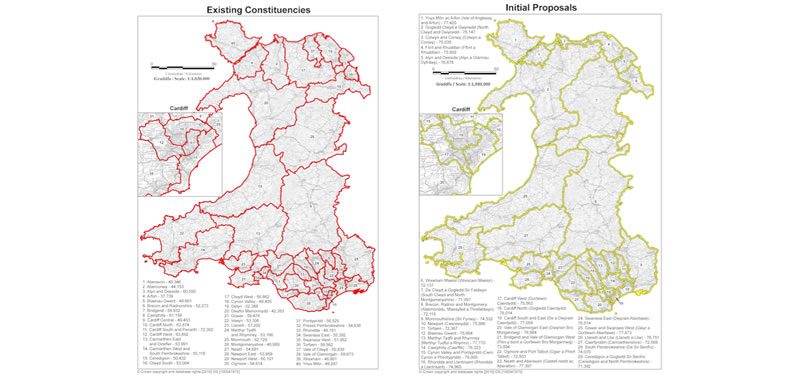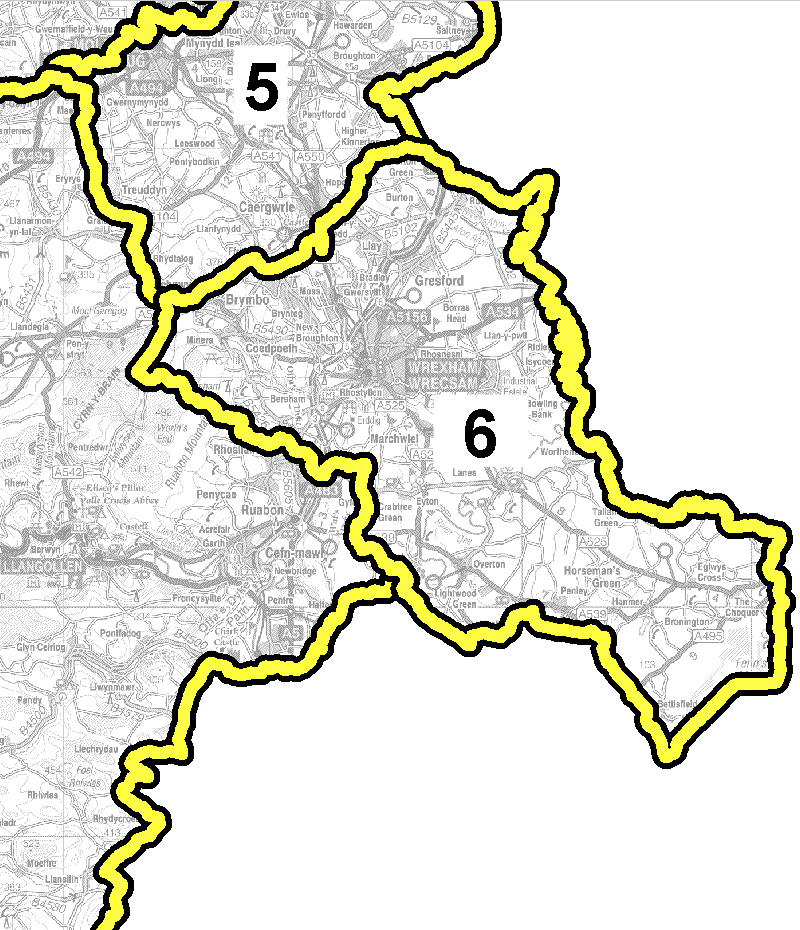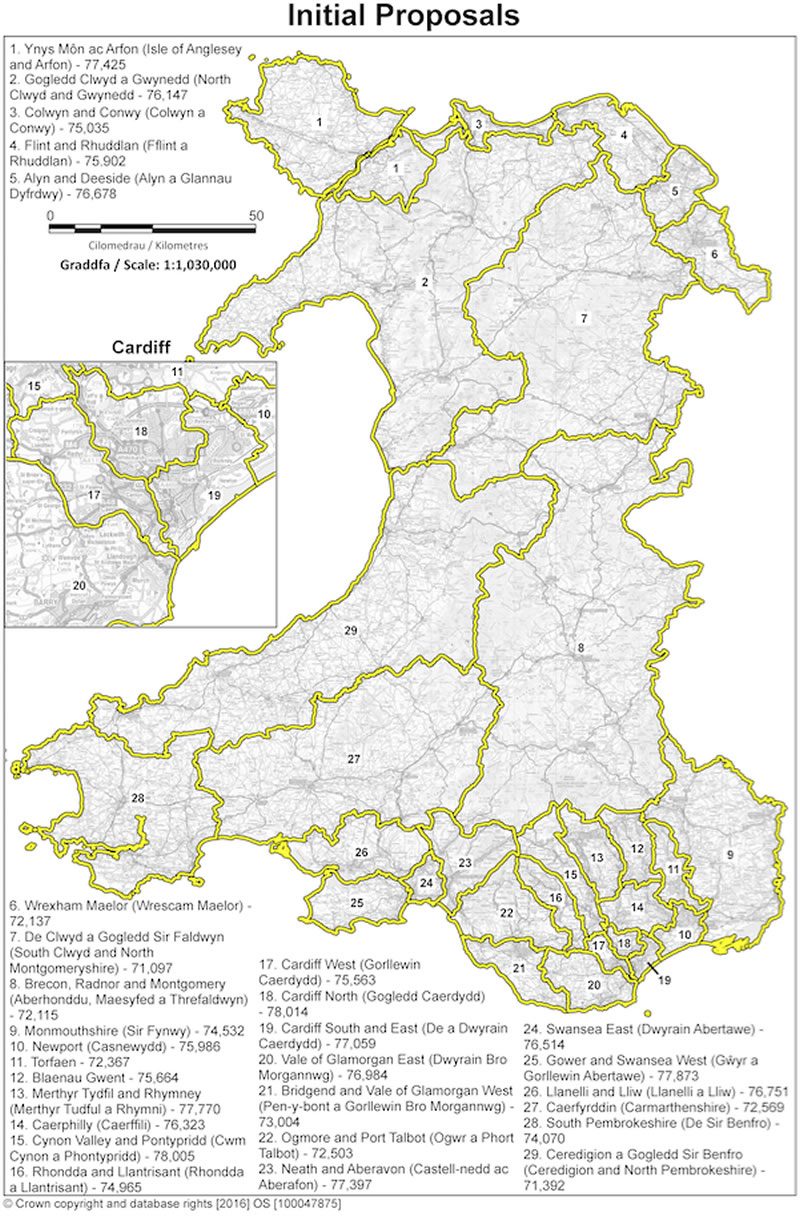Proposals to Change Wrexham & Clwyd South Constituencies – North Wales Down To 7 MPs

The Boundary Commission for Wales is today publishing comprehensive details of its initial proposals for a revised Parliamentary constituency map – resulting in drastic to Wrexham and Clwyd South.
The plans would see North Wales go from twelve MP’s down to seven if the proposals are firmed up – with the remaining 33 being in South Wales.
Wrexham and parts of Clwyd South would become Wrexham Maelor, and South Clwyd and North Montgomeryshire.
Today’s launch marks the start of a 12-week public consultation period during which the Commission is asking people to ‘have their say’ on the proposals either by submitting written representations by post or online or by making oral submissions at one of five hearings that will take place across Wales.
The Parliamentary Voting System and Constituencies Act 2011 requires a reduction in the number of UK constituencies from 650 to 600 and for every UK constituency to have an electorate within the range of 71,031 to 78,507.
This is the registered electorate, rather than population, so areas could be misrepresented if they have a less engaged population.
We have created the below animation showing the changes from the current boundaries, in red, to the proposed in yellow:

The full initial report (We have the full 15 meg PDF here on Wrexham.com) notes for the Wrexham changes that a ‘county constituency is created from…..’
The whole of the existing Wrexham CC and County Borough of Wrexham electoral wards of Acton (2,141), Borras Park (1,941), Brynyffynnon (2,190), Cartrefle (1,547), Erddig (1,437), Garden Village (1,614), Gresford East and West (2,202), Grosvenor (1,518), Gwersyllt East and South (3,599), Gwersyllt North (1,967), Gwersyllt West (2,141), Hermitage (1,549), Holt (2,411), Little Acton (1,812), Llay (3,519), Maesydre (1,402), Marford and Hoseley (1,818), Offa (1,383), Queensway (1,436), Rhosnesni (2,838), Rossett (2,544), Smithfield (1,364), Stansty (1,631), Whitegate (1,590), and Wynnstay (1,267);
AND
The electoral wards within the existing Clwyd South CC and County Borough of Wrexham of Bronington (2,540), Brymbo (2,982), Bryn Cefn (1,482), Coedpoeth (3,482), Esclusham (2,023), Gwenfro (1,214), Marchwiel (1,824), Minera (1,843), New Broughton (2,649), Overton (2,601) and Ponciau (without the Ponciau North, Ponciau South and Rhos wards of the Community of Rhosllanerchrugog) (636).
The document adds: “This constituency would have 72,137 electors which is 3.5% below the UKEQ of 74,769 electors per constituency. The suggested name for the constituency is Wrexham Maelor. The suggested alternative name is Wrecsam Maelor.
“The electorate in the existing Wrexham constituency is not sufficient to form a constituency so consideration was given to combining electoral wards in the surrounding areas. It was considered appropriate to combine the existing Wrexham constituency with electoral wards of the existing Clwyd South constituency to the south and west of Wrexham.
“The additional electoral wards immediately adjacent to the existing Wrexham constituency are predominantly residential areas which may look to Wrexham as a centre of employment, retail and social activities.”
“The electoral ward of Ponciau is comprised of the Aberoer and Pentrebychan wards of the Community of Esclusham and the Ponciau North, Ponciau South and Rhos wards of the Community of Rhosllanerchrugog.
“The Commission proposes placing the Aberoer and Pentrebychan wards of the Community of Esclusham into the proposed Wrexham Maelor constituency with remaining wards of the Community of Rhosllanerchrugog forming part of the proposed constituency of South Clwyd and North Montgomeryshire ”
Similarly for Clwyd South it reads: “The following parts of the existing Clwyd South CC consisting of: The County of Denbighshire electoral wards of Corwen (1,826), Llandrillo (930) and Llangollen (3,319); and, ii. the County Borough of Wrexham electoral wards of Cefn (3,709); Ceiriog/Ceiriog Valley (1,670), Chirk North (1,811), Chirk South (1,549), Johnstown (2,415), Llangollen Rural (1,578), Pant (1,534), Penycae (1,479), Penycae and Ruabon South (1,898), Plas Madoc (1,198), Ruabon (2,071) and Ponciau (without the Aberoer and Pentrebychan wards of the Community of Esclusham) (2,831);”
The full changes proposed on the maps released are as follows:

The proposed new Parliamentary constituencies are in full: Alyn and Deeside; Blaenau Gwent; Brecon, Radnor and Montgomery; Bridgend and Vale of Glamorgan West; Camarthen; Caerphilly; Cardiff North; Cardiff South and East; Cardiff West; Ceredigion and North Pembrokshire; Colwyn and Conwy; Cynon Valley and Pontypridd; Clwyd South and Montgomeryshire; Flint and Rhuddlan; North Clwyd a Gwynedd; Gower and Swansea West; Llanelli and Lliw; Merthyr Tydfil and Rhymney; Monmouthshire; Neath and Aberavon; Newport; Ogmore and Port Talbot; Rhondda and Llantrisant; South Pembrokeshire; Swansea East; Torfaen; Vale of Glamorgan East; Wrexham Maelor; and, Ynys Môn and Arfon .
16 existing constituencies would be wholly contained within a new constituency: Alyn and Deeside, Blaenau Gwent, Brecon and Radnorshire, Bridgend, Cardiff West, Ceredigion, Cynon Valley, Llanelli, Merthyr Tydfil and Rhymney, Neath, Ogmore, Rhondda, Swansea East, Torfaen, Wrexham and Ynys Môn.
Compliance with the legislation requires a reduction in the number of constituencies in Wales from 40 to 29, which is the biggest single change to Wales’ electoral map since the Boundary Commission was created in 1944.
There are changes to every constituency contained in the Commission’s Initial Proposals, and some of the proposed alterations are considerable. The Commission has, however, ensured that the Initial Proposals – published today are fully compliant with the requirements of the legislation.
The Commission points out that, while its proposals meet the statutory criteria, it has also taken into account other relevant factors important to Wales, such as: geographical considerations, including the size, shape and accessibility of constituencies, local government boundaries; boundaries of existing constituencies and any local ties that would be broken by changes in constituencies.
Steve Halsall, Secretary to the Commission, said today: “The Commission has produced a set of initial proposals which meet the requirements of the 2011 Act. It has also taken into account other relevant factors and has sought to identify the solutions most suitable to local needs within Wales.
“I would emphasise that these are initial proposals and I very much hope that members of the public will participate in the process of consultation which now begins.”
The Commission has considered the merits of a number of options. Some potential solutions considered proved not to be viable because they cannot be accommodated within the statutory requirement as to the size of the electorate or because of their knock-on effect on other constituencies.
The Commission has sought in its initial proposals to identify the solutions most suitable to local needs within Wales. It now wants to hear what people of Wales think.
Mr Halsall added: “Over the next 12 weeks people may visit our consultation portal, write in or email us to let us know what they think of the Commission’s proposals. Whether they accept or object, we are keen to hear people’s views. Where they object – particularly where they can supply counter-proposals – the Commission will give full consideration and may amend its proposals accordingly.”
As part of the initial consultation the Commission is required to hold public hearings, providing an opportunity for people to make oral representations about any of the Commission’s current proposals and to present any counter-proposals. The locations, venues and dates of the 5 public hearings to be held across Wales are:
12 – 13 October 2016 in Carmarthen, Ivy Bush Royal Hotel
19 – 20 October 2016 in Bangor, The Management Centre, Bangor University
26 – 27 October 2016 in Cardiff, Mercure Holland House
02 – 03 November 2016 in Llandrindod Metropole Hotel
09 – 10 November 2016 in Wrexham, Catrin Finch Centre, Glyndwr University
Those wishing to make oral representations at any of the above hearings are requested to contact the Commission by email on [email protected] or by telephone on 029 2046 4819 confirming the preferred date and time they wish to make their representation. The Commission will write to all of those who make a request with further information about the hearings and provide an allocated timeslot.
All representations will be published at a later date (in Welsh and English) and a ‘secondary consultation period’ will then take place.
The Commission’s final proposals will be submitted by October 2018.
Full details are available at www.bcomm-wales.gov.uk www.bcw2018.org.uk http://bcomm-wales.gov.uk/2018-review/faqs?lang=en
Spotted something? Got a story? Email [email protected]












